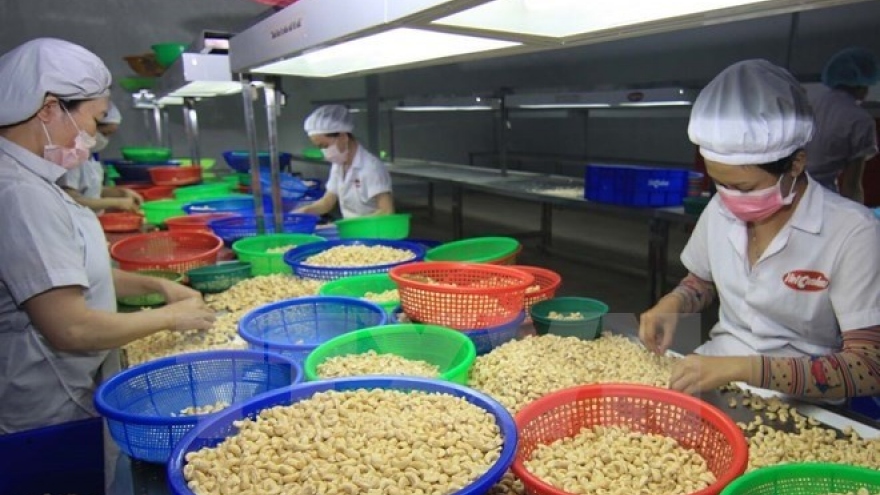Outcomes of FDI-reliant economy
Vietnam’s economy has the highest ratio of exports against the gross domestic product (GDP) in the world.
 |
|
|
With this high ratio, Vietnam’s economy is vulnerable to crisis if its exports or materials needed for export production are obstructed by other countries due to disputes, or foreign investors leave the country to seek other destinations for lower production cost or return to their home countries following the trend of using robots to replace physical labor.
According to the International Labor Organization, 56% of workers in five Southeast Asian countries may be replaced with robots and more than 90% of workers in the apparel and footwear industries in countries like Vietnam and Cambodia are under this robot replacement threat.
More reliant on FDI
Vietnam’s foreign trade has enjoyed some surplus since 2012 thanks to the FDI sector (see chart), as the sector has gained trade surplus while the domestic sector has continued to suffer trade deficit. In 2017, the FDI sector made up 71% of Vietnam’s total exports and 60% of total imports.
Domestic enterprises accounted for less than 28% of total exports, and mainly suffered trade deficit, which amounted to US$23 billion.
Meanwhile, the FDI sector gained a trade surplus of nearly US$26 billion. So, it can be said that domestic enterprises have no capacity to produce goods so as to enter the global marketplace, and the country is mainly a consumption market for foreign goods.
FDI in Vietnam has increased strongly since 2008, reaching over US$10 billion annually. In 2016, Vietnam attracted a record high FDI of nearly US$16 billion, accounting for 23% of the total investment in the economy, while investment by the State sector made up 38% and the local private sector 39%.
Hardly no countries in the world have a high ratio of FDI against total investment like Vietnam.
In terms of GDP, FDI in Vietnam is equal to 7.7% of GDP, more than double the world’s average ratio of 3.1%, much higher than Indonesia (0.5%), Thailand (0.8%), China (1.5%) and Malaysia (4.6%) and below only Singapore (20.7%) and Hong Kong (41%), whose economies are based mainly on transshipment and financial intermediary services (2).
A deeper insight shows how foreign investors have taken advantage of Vietnam’s cheap labor. Though the import/export ratio of the FDI sector has dropped, it remains very high, at over 80%, an indication that the localization ratio and the ripple effect of the sector are insignificant. Based on data in 2015, the localization ratio is estimated at roughly 22% (3).
Cheap labor exploitation, no technology transfer
The investment per worker in the FDI sector is very low, even below the investment by the local private sector, as shown by the General Statistics Office (GSO)’s statistics on enterprise production efficiency in 2010-2014.
In 2014, the average number of workers in an FDI enterprise is 312, only half of the number of workers in a centrally-run State-owned enterprise (SOE) and a little bit higher than the number in a locally-run SOE.
However, the investment per worker by an FDI enterprise is lower than that by a local private enterprise (VND1.1 billion compared with VND1.4 billion) and is equal to only 25% of the investment by an SOE. It’s impossible to have high technology with such a low investment. Therefore, there is no high-tech transfer by the FDI sector.
Technology transfer should be viewed from two aspects: (1) The foreign investor realizes the potential of high-tech labor in Vietnam and focus production and training on this area, (2) The Vietnamese Government must improve science and technology education, especially at the tertiary level, to be able to receive new technologies.
Both these aspects are not in the mind of the authorities and the investors, except for a few investors like Intel.
Profit equal to trade surplus
In essence, foreign investors have only taken advantage of cheap labor in Vietnam to make profit and contributed insignificantly to technology transfer as well as the industrialization process in the country. At present, the profit which FDI enterprises can repatriate home is around US$12 billion, just equal to the trade surplus they have gained and nearly equal to the annual increase in FDI capital.
By the author’s calculation, between 1998 and 2014, the total FDI capital by book value is US$141.9 billion (recalculated by the 2014 prices) (4).
Based on the supposition that the product life of an FDI is 15 years as calculated by investors worldwide, the remaining value after deduction of accumulated depreciation is US$69 billion by end-2014 (5). With the profit of US$11.7 billion as per the enterprise survey, the profit rate is 16.9% per year (based on reports and the 20% profit tax payable by end-2014).
Based on this profit rate, the profit of the FDI sector in 2017 is estimated at US$14.9 billion. The profit repatriable after tax is US$12 billion, and the actual amount repatriated as per the payment balance in 2017 is US$10.3 billion. So, the profit repatriable is equal to the trade surplus the FDI sector has gained.
Aftermath of FDI attraction at all costs
On the ground of facilitating investment, some local authorities are willing to take back land of people at low prices and transfer it to investors, foreign and local alike. The more land they take back, the more kickbacks they receive. As a result, backyard private companies have a chance to provide services for those investors.
However, over the long term, with the use of robots, both simple and smart robots, in developed countries to increase production and compete in prices and quality with China and developing countries, investors from developed countries may take back offshore jobs in countries like Vietnam.
Aware of this threat, China has mapped out high-tech development programs and moved low-tech factories to Vietnam. However, the employment of low technology and low skilled, cheap labor may not last long, as they cannot compete with robot-based production. Vietnam will be left behind if the country is not fully aware of this situation. In sum, the motto of industrialization is becoming outdated. The matter is to determine the industry.



